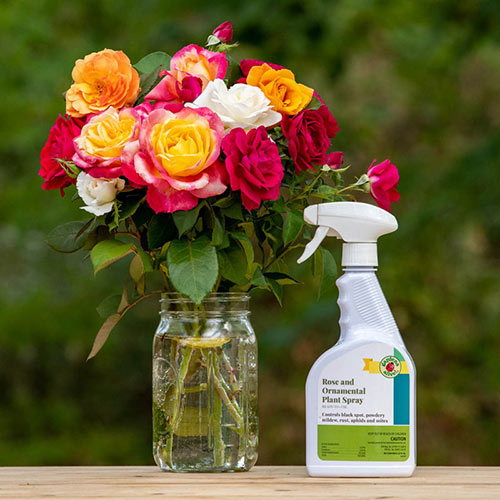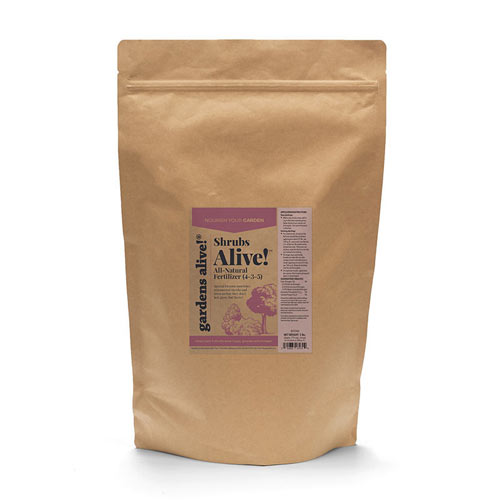The Best Foundation Plants For the Front of Your House
-
Helpful Products from Gardens Alive!
-
 Rose & Ornamental Plant Spray
Rose & Ornamental Plant Spray -
 Shrubs Alive!™ Fertilizer for Trees and Shrubs
Shrubs Alive!™ Fertilizer for Trees and Shrubs
Plants for front of house can make a big impression and improve curb appeal. However, because these bushes and shrubs are next to the house foundation, care must be taken in selecting and planting foundation plants. Read on to learn about what to plant next to house foundation.
What Are Foundation Plants?
Foundation plants are the shrubs or plants that are in front of the walls and under the windows of the house. Foundation plantings improve curb appeal--and the best foundation plantings help tie the house into the landscape. Foundation plantings may be a line of shrubs or other plants in front of house. Foundation plantings may also be a mixed perennial garden or a combination of perennials and bushes.
What Are the Best Plants For the Front of the House?
When selecting plants for landscaping around the house foundation, look for plants that are low maintenance and easy to grow in your area. Also note their mature height and width. When landscaping next to house foundation, the plants, at maturity, should be at least 1 foot away from the house. Here are some of the best plants for front of house, including shrubs you can plant close to the house.
- Boxwoods: Evergreen and easy to shape, these shrubs are some of the most popular for foundation plantings. Shorter, dwarf varieties are excellent bushes for front of house.
- Junipers: Evergreen shrubs provide year-round color and are available in various sizes, including low-growing bushes that fit neatly under windows.
- American Holly: Evergreen shrub with shiny, dark green leaves provides much-needed color in the winter months.
- Dwarf Blue Spruce: Evergreen, blue-green needles provide fantastic color throughout the year.
- Hydrangeas: Some of the most popular deciduous, flowering shrubs available, hydrangeas provide structure and color.
- Roses: Easy-to-grow landscape roses often bloom for months providing brilliant color around the house.
- Dwarf Lilacs: While standard lilacs can grow quite large, dwarf varieties are more manageable and still provide lovely color and fragrance.
- Hosta: Shade-loving perennial is a good choice for planting on the north sides of houses or other places that may not receive as much sun.
- Sedum: Low-growing, sun-loving perennial requires little maintenance and adds color and interest.
- Blue Fescue Grass: Smaller ornamental grass provides color and texture.
Expert Advice
How Close Can You Plant Next to a House?Q. Are there ornamental grasses or other plants with less invasive roots that I can plant right up next to my house? I have a brick home with a concrete foundation and would like to plant something next to the house to cover up the first brick or two and give some 'volume' right next to the house. Obviously, moisture and roots are problems I have to worry about. I know that the conventional advice is to plant further out than the plant's dripline. But is there anything I can plant closer in, right up against the house?
---Phil in Wyndmoor, PA
A. No. Good air circulation is key to both healthy home and horticulture. You should always leave a foot of open space around the foundation to prevent moisture build up that can lead to mold and damaging dampness (and to avoid giving insects like carpenter ants and termites direct access to your home). Distance is good for the health of the house—and the plants.
Now, ornamental grasses are my favorite screening plant; and they would provide the desired "volume", but they'd look awful right up against the house or in a tight row. You'd have to start them further out and stagger them in two properly positioned checker-board rows with some space between each plant. And no matter what the plant choice, you must always plan for their 'final size'. A Christmas tree-sized blue spruce, for instance, may only have a 'skirt' that's four or five feet wide when its newly-planted, but in a decade that skirt will have widened to 20 feet.
So: to estimate the safe planting distance from the side of a structure, take half of a plant's 'final width' and add a foot; that's close to a perfect rule for most plants.
Now I'm going to go in a different direction to obscure those bottom bricks. The National Renewable Energy Laboratory suggests planting low-growing evergreen shrubs where their furthest mature edge will end 12 to 18 inches away from the foundation. That'll block what is generally the least attractive view of any house, and help insulate your home by blocking the direct path of icy winds in winter. And that same natural insulating factor will help keep the house cooler in summer.
There are some low-growing evergreen grasses; and all ornamental grasses provide the 'evergreen' benefit of holding their leaves over the winter, even though most are going to go dormant and turn brown. But I don't think they'd look good in a tight row. A line of low-growing juniper would block the view of the bottom of the house, achieve those energy extras and look great. And there's a huge selection of juniper varieties that are totally lateral. Really attractive plants, very easy care, well-behaved roots…
But I'm always suggesting junipers; are there other evergreens that grow low?
I have zero background in plant selection, so to learn the answer I dove into book and website suggestions; and found a great article at "SFGate"—the website of the San Francisco Chronicle newspaper. They describe a creeping form of Norway spruce that is hardy from the most frigid parts of the country all the way South to USDA Zone 8. (The article points out that nurseries generally stake these plants to be upright, but left on their own they will trail nicely across the ground.)
There are also 'prostrate pines' with the same low habit that are just as hardy. And, like me, the authors of the article rave about junipers, noting that there are literally hundreds of varieties with a low growing spreading habit that do well in most parts of the country.
Now: what about the 'volume' issue?
The traditional advice on layering a landscape is to have the smallest plants in the front and the tallest ones closest to the house, so you can see the progression of plants, but the taller the plant, the further it needs to be positioned away from the house; ideally following that 'half of the full final width plus a foot' rule. And we don't know how much room this landscape has.
So I'm going to try and pretend to be a landscape designer—with the warning that you should talk with a real one or research your choices carefully before proceeding. Now, let's begin by installing that wonderful line of low-growing evergreens, planted and/or pruned so that the back ends of the plants are about a foot away from the house.
Then we can add 'volume' with a few 'specimen' plants in front of that. Depending on the width of the area, one to three dramatic plants installed with a good amount of space between them would look spectacular. I think weeping cherries are fabulous for this, and it would be a great way to show off a couple of ornamental grasses.
But again, not in a tight row. You want to be able to appreciate the great structure of these specimen plants. (And see that great little evergreen hedge behind them.) And of course, don't plant anything close to a water line or sewer pipe. And make sure there are no underground utilities before you dig. ("Call 811 before you dig!")
https://homeguides.sfgate.com/types-lowgrowing-spreading-evergreen-shrubs-68849.html
-
Helpful Products from Gardens Alive!
-
 Rose & Ornamental Plant Spray
Rose & Ornamental Plant Spray -
 Shrubs Alive!™ Fertilizer for Trees and Shrubs
Shrubs Alive!™ Fertilizer for Trees and Shrubs







 Gardens Alive! & Supplies
Gardens Alive! & Supplies




